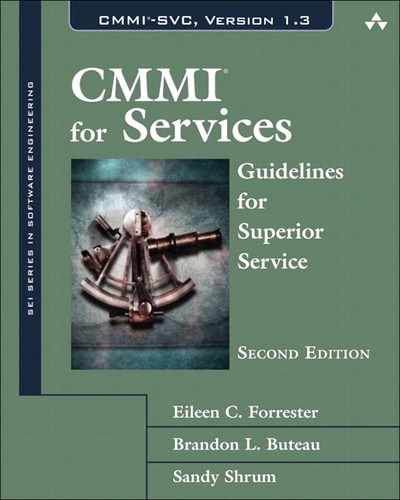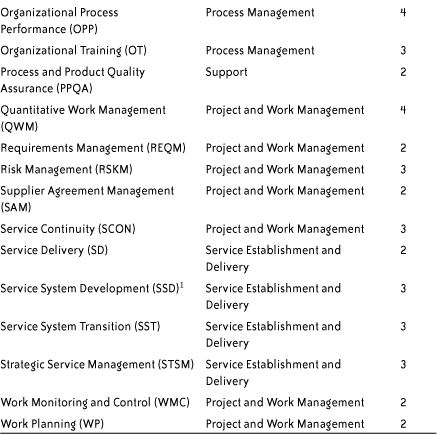Chapter 4. Achieving Process Improvement that Lasts
Overview
This chapter explains how CMMI models ensure lasting process improvement. Making improvements to achieve business objectives is only half the job. The other half is ensuring that these improvements persist over time.
Lasting Improvement
Lasting improvement requires establishing processes that are institutionalized, which means they are absorbed into the organization’s standard way of doing business.
How do processes become institutionalized? Research has shown that to become institutionalized, processes must be supported by the organization. In CMMI models, this support is embodied in the generic goals and practices. That is why implementing only the specific practices of a process area is not enough; you must also implement the generic goals and practices.
Understanding Generic Practices
Generic practices ensure a degree of permanence in a variety of ways that include, but are not limited to, the following:
• Creating policies and securing sponsorship
• Ensuring that the work unit and/or organization has the resources it needs
• Managing the performance of the process, managing the integrity of its work products, and involving relevant stakeholders
• Reviewing the process with higher level management and objectively evaluating its conformance to process descriptions, procedures, and standards
The generic goals and practices are listed in the first section of Part Two, including notes and subpractices that further explain them. Applied sequentially, the generic goals describe characteristics of increasingly institutionalized processes. Generic goals and their practices are designed to be applied to processes associated with each process area.
Achieving GG 1 for a process area is achieving the specific goals of a selected process area.
Achieving GG 2 for a process area is managing the performance of processes associated with the process area. This management includes a policy that indicates you will perform the process, a plan for performing the process, resources, assigned responsibilities, training, controlled work products, and so on.
Achieving GG 3 for a process area assumes that an organizational standard process exists that can be tailored to result in the process you will use.
These generic goals and generic practices are used as part of achieving capability and maturity level ratings. Table 4.1 illustrates the relationships between the generic goals and practices and the maturity and capability levels.
Table 4.1 Model Elements Affecting Process Institutionalization

Understanding Capability Levels
The capability level of a process area indicates how lasting the associated processes are likely to be. A process area is given a capability level rating based on the highest generic goal satisfied.
Implementing only the specific practices of a process area will achieve capability level 1, which means that the process is performed, but it may not last.
As the organization implements the generic practices for a process, it increases the chances that the process will become part of the way the organization does business. Capability levels measure this increase in permanence for each process area by generic goal (or group of generic practices) as described in Table 4.2.
Table 4.2 Capability Levels and Generic Goals
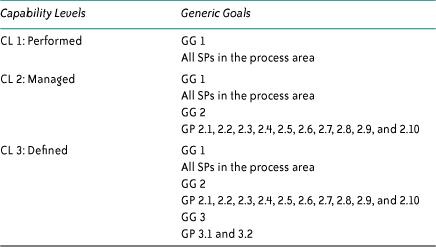
Using Capability Levels
Capability levels enable the organization to focus its process improvement efforts process area by process area. Once you select a process area, you must decide how much you want to improve the processes associated with that process area (i.e., select the appropriate capability level).
For example, an organization may wish to reach capability level 2 in one process area and capability level 3 in another. As the organization achieves a capability level, it sets its sights on the next capability level for one of these same process areas or decides to widen its view and address additional process areas relevant to its business goals.
Process areas are organized into four categories: Process Management, Project and Work Management, Service Establishment and Delivery, and Support. These categories emphasize some of the key relationships that exist among the process areas.
Sometimes an informal grouping of process areas is used, such as high maturity process areas. The four high maturity process areas are Organizational Process Performance, Quantitative Work Management, Organizational Performance Management, and Causal Analysis and Resolution. These process areas focus on improving the performance of implemented processes that most closely relate to the organization’s business objectives.
The selection of a combination of process areas and capability levels is typically described in a “target profile.” A target profile, as depicted in Figure 4.1, defines all of the process areas to be addressed and the targeted capability level of each. This profile governs which goals and practices the organization will address in its process improvement efforts.
Figure 4.1 A Sample Target Profile
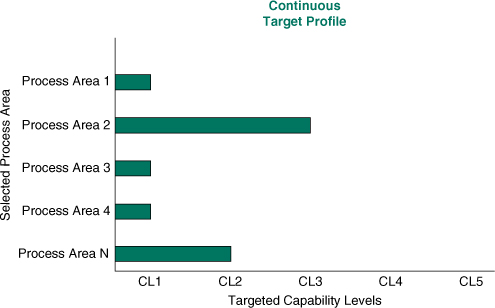
Most organizations, at a minimum, target capability level 1, which requires that all specific goals of the process area be achieved. However, organizations that target capability levels higher than 1 concentrate on the institutionalization of selected processes in the organization by implementing the associated generic goals and practices.
After your organization reaches capability level 3 in the process areas it has selected for improvement, it can continue by addressing high maturity process areas (Organizational Process Performance, Quantitative Work Management, Causal Analysis and Resolution, and Organizational Performance Management).
The high maturity process areas focus on improving the performance of the processes already implemented. The high maturity process areas describe the use of statistical and other quantitative techniques to improve organizational and work group processes to better achieve business objectives.
When continuing their improvement journey in this way, organizations derive the most benefit by first selecting the OPP and QWM process areas, and bringing those process areas to capability levels 1, 2, and 3. These processes enable the organization and its work groups to align the selection and analyses of processes more closely with its business objectives.
After the organization attains capability level 3 in the OPP and QWM process areas, it can continue its improvement path by selecting the CAR and OPM process areas. These processes enable the organization and its work groups to systematically identify and deploy incremental and innovative improvements that improve overall performance.
Understanding Maturity Levels
Maturity levels indicate how advanced an organization’s processes are as a whole and how well the organization has achieved capability levels in a wide array of process areas. Each process area has a maturity level assigned to it; for example, the Configuration Management process area is a maturity level 2 process area. To achieve a maturity level, all of the goals of the process areas and generic goals belonging to that maturity level must be satisfied.
In other words, maturity level 2 (the lowest available maturity level) means that more than just the generic goals and practices are implemented for a single process area; it means that a whole set of process areas was implemented (including specific practices and generic practices).
An organization achieves a maturity level rating based on the highest generic goal implemented and the highest maturity level process areas satisfied. (Maturity levels are less directly related to generic practices than capability levels, but they do relate.) Maturity levels are implemented in order from 2 through 5.
As the organization achieves increasing maturity levels, it reinforces the process that will become part of the way the organization does business. Maturity levels measure this increase in permanence as described in Table 4.3.
Table 4.3 Maturity Levels, Process Areas, and Generic Goals
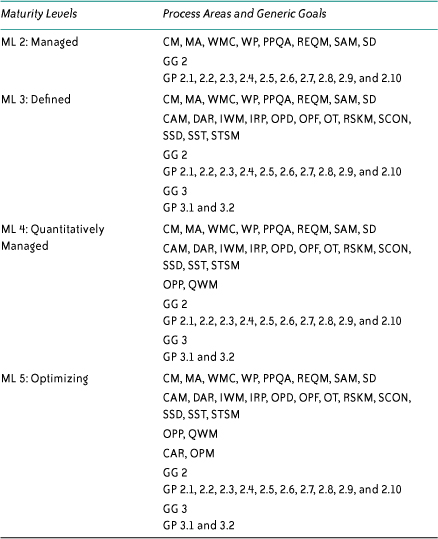
Once you reach maturity levels 4 and 5, the maturity levels no longer rely on the generic practices to increase control and permanence. These characteristics are achieved by the maturity level 4 and 5 process areas themselves.
The maturity level 4 and 5 process areas focus only on subprocesses that are indicators for the critical aspects of your business.
Measuring subprocesses, statistically managing them, and subsequently optimizing their selection and performance is a way to control a process to ensure that it continues successfully. That is the purpose and function of the process areas staged at maturity levels 4 and 5.
Using Maturity Levels
Maturity levels provide a staging of processes for improvement across the organization from maturity level 1 to maturity level 5. This improvement involves achieving the goals of the process areas at each maturity level. Process areas can be grouped by maturity level, indicating which process areas to implement to achieve each maturity level.
For example, at maturity level 2, there is a set of process areas that an organization could use to guide its process improvement until it satisfies all the goals of all these process areas. Once maturity level 2 is achieved, the organization focuses its efforts on maturity level 3 process areas, and so on. The generic goals that apply to each process area are predetermined. Generic goal 2 applies to maturity level 2 and generic goal 3 applies to maturity levels 3 through 5.
Using Capability Levels and Maturity Levels
Capability levels support focused improvement within a single process area of the model. Maturity levels measure the overall improvement of the organization. However, both are simply different ways of viewing improvement using the same CMMI practices.
You can use capability levels to track improvement in single process areas while working toward a long-term goal of overall improvement for your organization, which can be measured by maturity levels.
Figure 4.2 demonstrates how capability levels and maturity levels work together to help you achieve improvement.
Figure 4.2 Process Areas in Continuous and Staged Representations

Figure 4.2 illustrates how organizations can focus on capability levels of a process area to ensure improvement of those processes while having a plan for the overall improvement of the organization’s processes in the framework of maturity levels. In this way, you can use capability levels and maturity levels to reach your process improvement objectives.
Table 4.4 provides a list of CMMI-SVC process areas and their associated categories and maturity levels.
Table 4.4 Process Areas and Their Associated Categories and Maturity Levels
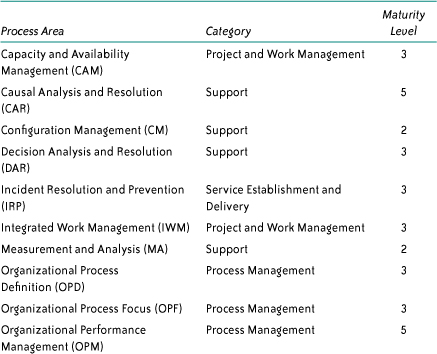
Equivalent Staging
Up to this point, we have not discussed process appraisals in much detail. The SCAMPI method2 is used to appraise organizations using CMMI, and one result of an appraisal is a rating [SEI 2011a, Ahern 2005]. If the continuous representation is used for an appraisal, the rating is a “capability level profile.” If the staged representation is used for an appraisal, the rating is a “maturity level rating” (e.g., maturity level 3).
A capability level profile is a list of process areas and the corresponding capability level achieved for each.
This profile enables an organization to track its capability level by process area. The profile is called an “achievement profile” when it represents the organization’s actual progress for each process area. Alternatively, the profile is called a “target profile” when it represents the organization’s planned process improvement objectives.
Figure 4.3 illustrates a combined target and achievement profile. The shaded portion of each bar represents what has been achieved. The unshaded portion represents what remains to be accomplished to meet the target profile.
Figure 4.3 An Example of a Target and Achievement Profile
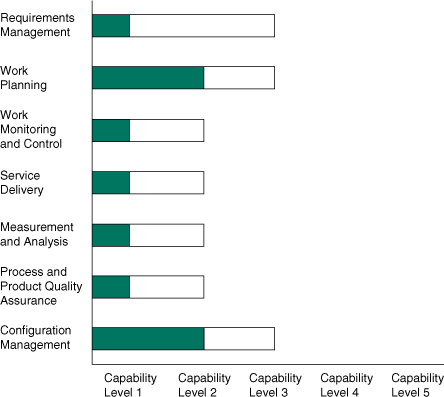
An achievement profile, when compared with a target profile, enables an organization to plan and track its progress for each selected process area. Maintaining capability level profiles is advisable when using the continuous representation.
Target staging is a sequence of target profiles that describes the path of process improvement to be followed by the organization. When building target profiles, the organization should pay attention to the dependencies between generic practices and process areas. If a generic practice depends on a process area, either to carry out the generic practice or to provide a prerequisite work product, the generic practice can be much less effective when the process area is not implemented.3
Although the reasons to use the continuous representation are many, ratings consisting of capability level profiles are limited in their ability to provide organizations with a way to generally compare themselves with other organizations. Capability level profiles can be used if each organization selects the same process areas; however, maturity levels have been used to compare organizations for years and already provide predefined sets of process areas.
Because of this situation, equivalent staging was created. Equivalent staging enables an organization using the continuous representation to convert a capability level profile to the associated maturity level rating.
The most effective way to depict equivalent staging is to provide a sequence of target profiles, each of which is equivalent to a maturity level rating of the staged representation reflected in the process areas listed in the target profile. The result is a target staging that is equivalent to the maturity levels of the staged representation.
Figure 4.4 shows a summary of the target profiles that must be achieved when using the continuous representation to be equivalent to maturity levels 2 through 5. Each shaded area in the capability level columns represents a target profile that is equivalent to a maturity level.
Figure 4.4 Target Profiles and Equivalent Staging
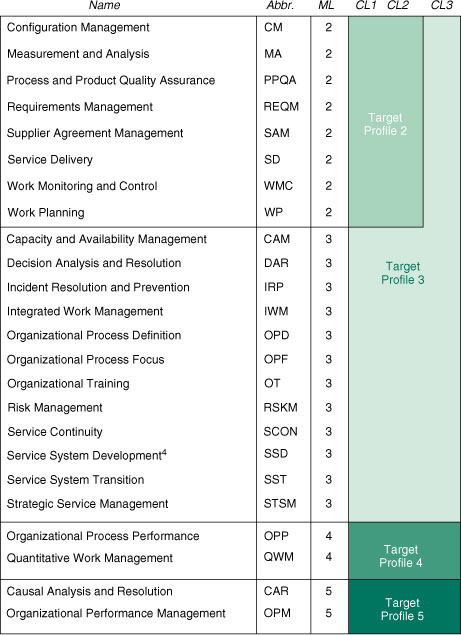
The following rules summarize equivalent staging.
• To achieve maturity level 2, all process areas assigned to maturity level 2 must achieve capability level 2 or 3.
• To achieve maturity level 3, all process areas assigned to maturity levels 2 and 3 must achieve capability level 3.
• To achieve maturity level 4, all process areas assigned to maturity levels 2, 3, and 4 must achieve capability level 3.
• To achieve maturity level 5, all process areas must achieve capability level 3.
Achieving High Maturity
When using maturity levels, you attain high maturity when you achieve maturity level 4 or 5. Achieving maturity level 4 involves implementing all process areas for maturity levels 4, 3, and 2. Likewise, achieving maturity level 5 involves implementing all process areas for maturity levels 5, 4, 3, and 2.
When using capability levels, you attain high maturity using the equivalent staging concept. High maturity that is equivalent to staged maturity level 4 using equivalent staging, is attained when you achieve capability level 3 for all process areas except for Organizational Performance Management and Causal Analysis and Resolution. High maturity that is equivalent to staged maturity level 5 using equivalent staging, is attained when you achieve capability level 3 for all process areas.
